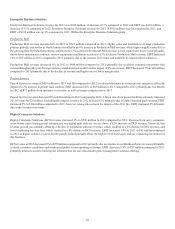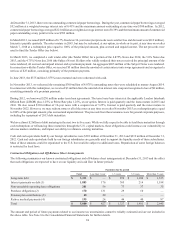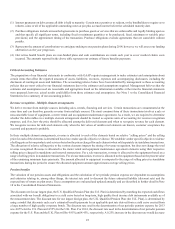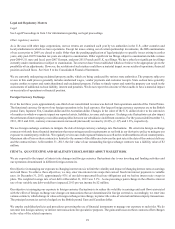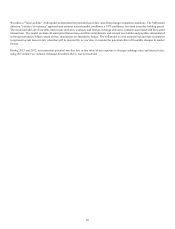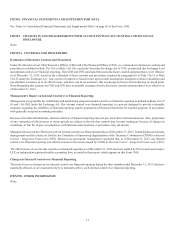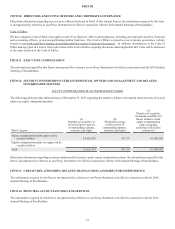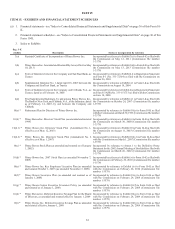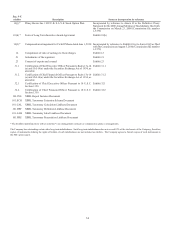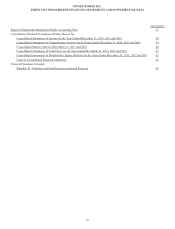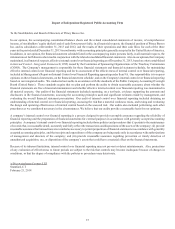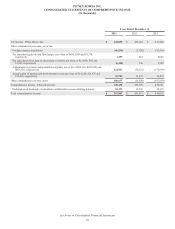Pitney Bowes 2013 Annual Report Download - page 40
Download and view the complete annual report
Please find page 40 of the 2013 Pitney Bowes annual report below. You can navigate through the pages in the report by either clicking on the pages listed below, or by using the keyword search tool below to find specific information within the annual report.29
Legal and Regulatory Matters
Legal
See Legal Proceedings in Item 3 for information regarding our legal proceedings.
Other regulatory matters
As is the case with other large corporations, our tax returns are examined each year by tax authorities in the U.S., other countries and
local jurisdictions in which we have operations. Except for issues arising out of certain partnership investments, the IRS examinations
of tax years prior to 2009 are closed to audit. Other than the pending application of legal principles to specific issues arising in earlier
years, only post-2007 Canadian tax years are subject to examination. Other significant tax filings subject to examination include various
post-2004 U.S. state and local, post-2007 German, and post-2011 French and U.K. tax filings. We have other less significant tax filings
currently under examination or subject to examination. Tax reserves have been established which we believe to be appropriate given the
possibility of tax adjustments. However, the resolution of such matters could have a material impact on our results of operations, financial
position and cash flows. See Note 8 to the Consolidated Financial Statements.
We are currently undergoing unclaimed property audits, which are being conducted by various state authorities. The property subject to
review in this audit process generally includes unclaimed wages, vendor payments and customer receipts. State escheat laws generally
require entities to report and remit abandoned and unclaimed property. Failure to timely report and remit the property can result in the
assessments of additional escheat liability, interest and penalties. We do not expect the outcome of these audits to have a material impact
on our results of operations or financial position.
Foreign Currency Exchange
Over the last three years, approximately one-third of our consolidated revenue was derived from operations outside of the United States.
The functional currency for most of our foreign operations is the local currency. Our largest foreign currency exposures are to the British
pound, Euro, Japanese Yen, Canadian dollar and the Australian dollar. Changes in the value of the U.S. dollar relative to the currencies
of countries in which we operate impact our reported assets, liabilities, revenue and expenses. Exchange rate fluctuations can also impact
the settlement of intercompany receivables and payables between our subsidiaries in different countries. For the years ended December 31,
2013, 2012 and 2011, currency rate movements increased/(decreased) revenue by (0.4)%, (1.1)% and 1.6%, respectively.
We use foreign exchange contracts to mitigate the risk of foreign currency exchange rate fluctuations. We enter into foreign exchange
contracts with only those financial institutions that meet stringent credit requirements as set forth in our derivative policy to mitigate our
exposure to counterparty credit risk. We regularly review our credit exposure balances as well as the creditworthiness of our counterparties.
Maximum risk of loss on these contracts is limited to the amount of the difference between the spot rate at the date of the contract delivery
and the contracted rate. At December 31, 2013, the fair value of our outstanding foreign exchange contracts was a liability value of $2
million.
ITEM 7A. QUANTITATIVE AND QUALITATIVE DISCLOSURES ABOUT MARKET RISK
We are exposed to the impact of interest rate changes and foreign currency fluctuations due to our investing and funding activities and
our operations denominated in different foreign currencies.
Our objective in managing our exposure to changing interest rates is to limit the volatility and impact of changing interest rates on earnings
and cash flows. To achieve these objectives, we may enter into interest rate swaps that convert fixed rate interest payments to variable
rates. At December 31, 2013, approximately 93% of our debt represented fixed rate obligations and we had no interest rate swaps in
place. The weighted average rate of our debt at December 31, 2013 was 5.1%. A one-percentage point change in the effective interest
rate of our variable rate debt would have impacted 2013 pre-tax income by $2 million.
Our objective in managing our exposure to foreign currency fluctuations is to reduce the volatility in earnings and cash flows associated
with the effect of foreign exchange rate changes on transactions that are denominated in foreign currencies. Accordingly, we enter into
various contracts, which change in value as foreign exchange rates change, to protect the value of external and intercompany transactions.
The principal currencies actively hedged are the British pound, Euro and Canadian dollar.
We employ established policies and procedures governing the use of financial instruments to manage our exposure to such risks. We do
not enter into foreign currency or interest rate transactions for speculative purposes. The gains and losses on these contracts offset changes
in the value of the related exposures.





